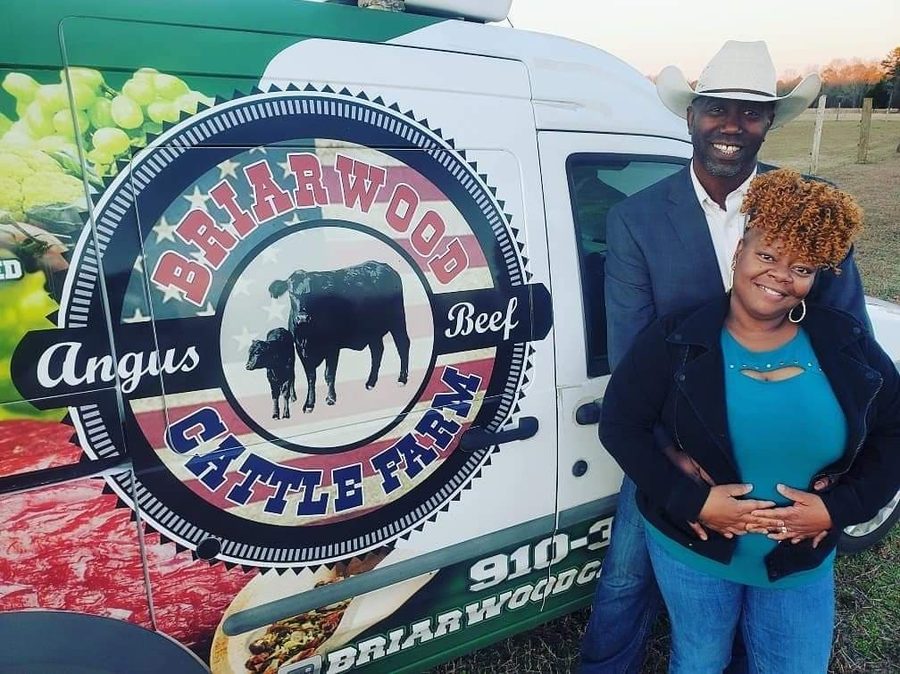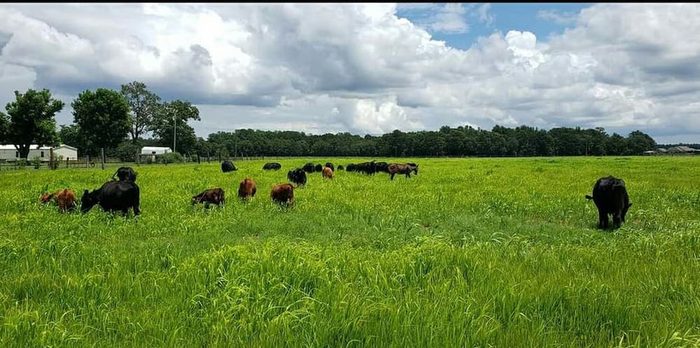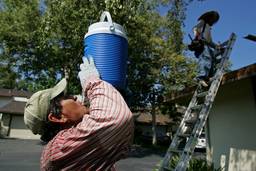Why Climate Plans Must Include Farmers of Color
Proposed legislation would give farms resources to fight climate change. Will farmers of color get equal access?
Hadassah Patterson

Marvin Frink looks out at his Black Angus cattle farm as the sun is coming up and ponders what’s on the horizon. He and his wife Tanisha started Briarwood Cattle Farm in Raeford, N.C. 10 years ago after Marvin was honorably discharged from the Army, where he served for 15 years, including on a Patriot missile crew. He recovered from service-related injuries and post-traumatic stress issues, and the Frinks purchased their first cattle in 2015 with a grant from the Farmer Veteran Coalition. Now their farm grows beef, pork and chicken available for delivery across the state.
Last year, the Frinks planned to purchase land to expand their cattle operation and incorporate regenerative grazing, a practice that involves frequently rotating grazing animals from pasture to pasture. Marvin Frink knows from his work that overgrazing the same land can be detrimental to the farm and the larger environment. “Regenerative grazing takes bad soil farmers can’t use and turns it back into reusable and sustainable land by having the cattle massage the soil and fertilize it,” he explains.
Regenerative grazing keeps the land and the animals healthy, prevents soil depletion, sequesters carbon, and cuts down on chemical inputs and greenhouse gas emissions. That’s important, because agriculture directly contributes 10% of U.S. greenhouse gas emissions, and the food system as a whole is responsible for as much as 57% of global emissions.
To implement regenerative grazing, the Frinks needed access to more land and applied for loans to buy it. But they were denied a loan, twice.
“Our credit wasn’t bad, and we had our cattle and farm (value) that superseded the loan,” says Marvin. “We were told we didn’t have enough equity yet.”
Like many farmers of color, the Frinks struggle to get access to farmable land. According to the 2017 Census of Agriculture, Black-owned farmland has shrunk from 15 million acres in 1920 to 4.7 million acres today — only .5% of all farmland in the United States. Unethical rural lenders, biased auction practices and exorbitant tax valuations have eaten into lands owned by farmers of color. Farmers of color also lack access to the capital needed to buy land and equipment, and timely resources for sustainability – such as severe weather insurance processing. This lack of access, and a history of outright discrimination at the U.S. Department of Agriculture (USDA), has left many farmers of color without the resources they need to make their operations more sustainable or to mitigate the effects of climate change on their land.
Existing carbon markets, which pay farmers for environmental contributions, offer a revenue opportunity for farmers of color to harmonize cultural, financial, and sustainability goals. But to participate fully, these farmers need to know these opportunities exist, which is too often not the case, and be empowered to participate equally. If farmers of color are struggling to maintain day to day operations, higher-level concerns such as rebates and credits can sometimes fall by the wayside. Right now, some farmers may even have to pay for third-party help to navigate certifications for carbon markets. For this reason, outreach programming is essential to plans that aim to ensure equal access to resources for farmers of color.
Marvin Frink hopes the Biden administration and Congress will address these problems. To start, he wants to see better access to resources for farmers of color and more equity so they can purchase land and equipment.

The Biden administration has made agriculture central to its campaign against climate change and Biden himself has said he envisions U.S. farmers being the first in the world to achieve net-zero carbon emissions. Meanwhile, Congress is debating a range of climate change legislation that would set clean energy standards and provide farmers the funding and tools to reduce emissions and engage with carbon markets for credit of their good work. But some senators are concerned the bills won’t help farmers of all backgrounds participate equally.
Among the over 100 proposed measures pertaining to the environment is the Growing Climate Solutions Act, reintroduced on April 20 by Sen. Mike Braun (R-I.N.), Sen. Debbie Stabenow (D-M.I.), Sen. Lindsey Graham (R-S.C.) and Sen. Sheldon Whitehouse (D-R.I.). The act offers a certification program for farmers, and would empower them to participate in carbon capture and soil improvement practices with provisions like technical assistance. It also provides a credit market rewarding “climate-smart practices” for producers. The U.S. Senate Committee on Agriculture, Nutrition, and Forestry advanced the bill to the Senate floor with broad bipartisan support from at least 49 senators and over 80 commercial and environmental organizations.
However, Sen. Raphael Warnock (D-G.A.) questioned whether the legislation adequately addresses the needs of farmers of color, who were hit particularly hard as the pandemic squeezed small farms and rattled agricultural markets. During a Senate Agriculture Committee hearing about the proposed legislation, Warnock put it this way: “Many of these farmers of color and their communities were disproportionately impacted by the Covid-19 pandemic, with less than .1% of the nearly $26 billion allocated for USDA Covid relief ending up in their pockets. As we work to address climate change and generate new revenue streams for our farmers, we must include farmers of color and their communities in these conversations. It is a matter of equity and justice. They cannot be left behind. They cannot be an afterthought.”
Asked about Warnock’s concerns, Stabenow spokesperson Patrick Delaney said, “the bill provides resources for smaller and medium-sized farmers to help them scale up the good work they’re doing and make sense of carbon markets.” Following Warnock’s comments, he said, “we made important improvements to ensure the new program, as well as the voluntary markets it supports, will address the unique needs of limited resource, historically underserved, and socially disadvantaged farmers, ranchers, and foresters.”
The Growing Climate Solutions Act will be considered by the full Senate once added to the calendar.
In February, Warnock himself introduced the Emergency Relief for Farmers of Color Act, which was referred to the Senate Agriculture Committee, where it remains. The bill would require the Secretary of Agriculture to provide assistance for socially disadvantaged farmers, ranchers and other groups.
Another upcoming piece of climate and farming legislation is the bicameral Agriculture Resilience Act, authored by Rep. Chellie Marie Pingree (D-M.E.) and introduced with 16 of her House colleagues. It was introduced in the Senate by Sen. Martin Heinrich (D-N.M.). The bill focuses on giving farmers tools to achieve net-zero carbon emissions by 2040. It also includes specific provisions, such as reserving 30% of land conservation funds for new and socially disadvantaged farmers, including farmers of color.
“Congress must ensure any resources provided to U.S. agriculture to fight climate change are accessible to farmers of color, particularly given past treatment by USDA,” Pingree told Rural America In These Times. “In the Agriculture Resilience Act, I propose policies to ensure farmers of color can benefit from these initiatives and are offered priority or lower matching requirements for grants and other incentives to adopt climate-smart farming practices.”
The bill also specifies that the plan should improve public health, resilience, and environmental impact in communities of color and tribal areas. The Agriculture Resilience Act was referred to the House Agriculture Committee.
This focus on racial equity in climate change legislation comes as USDA is grappling with a history of discrimination that has steadily decreased the numbers of Black farmers and robbed them of family farms for generations. Congress and the Biden administration took a step to address this history by setting aside $4 billion of the $1.9 trillion American Rescue Plan for debt relief for farmers of color, and an additional $1 billion to improve land access and retention.
Asked what USDA, which oversees the distribution of funds and informational programming, is doing to ensure equitable access, USDA Communications Director Matt Herrick said the debt relief in the American Rescue Plan offered immediate aid to farmers of color, to help them to sustain regular operations. Herrick also said that the new leadership at USDA is revising the agency’s approach to ensure more equitable access to all funding and programs, including creating the Office of the Assistant Secretary for Civil Rights (OASCR). The agencies recently established an independent Racial Equity Commission to examine USDA programs and services for accountability within the department, and to empower socially disadvantaged producers to take full advantage of programs.
USDA is “committed to follow through with actions led from the top by the Secretary [Tom Vilsack], the Senior Advisor for Racial Equity [Dewayne Goldmon], and OASCR,” Herrick said. “We see the upcoming Farm Bill [in 2023] as a perfect opportunity to work with Congress to address structural barriers found in the statutes that authorize critical USDA programs and activities.”
The Frinks are determined to see their farm grow sustainably, and have specific goals to get there. “I’m in need of $50,000 now to purchase land,” said Marvin Frink. But they’re willing to learn more about incentive programs. When asked what makes them so determined, he stated, “creating generational wealth and leaving a legacy standing on God’s faith.”
Hadassah Patterson has written for news outlets for over a decade, with seven years contributing for local online news and 15 years of commercial copywriting experience. She currently covers politics, business, social justice, culture, food and wellness.




